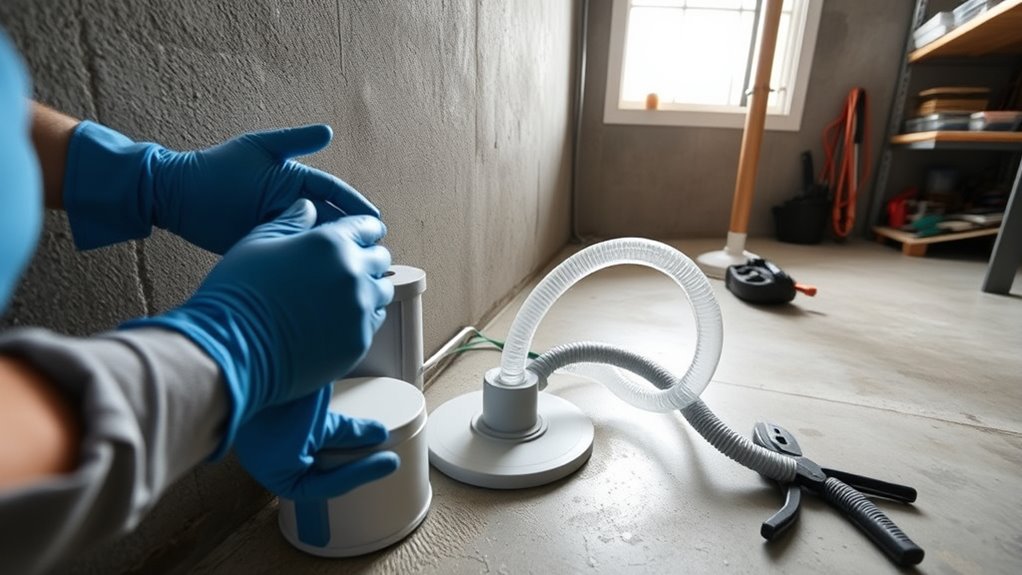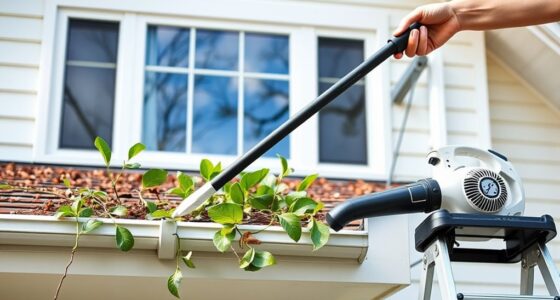Spending just 30 minutes weekly on a quick home inspection can catch small issues before they turn into costly repairs. Check your roof for damage after storms, clear gutters to prevent water runoff, and look for signs of leaks or water damage inside. Inspect windows, doors, and exterior walls for gaps or cracks. Regularly doing these simple checks helps prevent big problems like mold, foundation damage, or leaks. Keep going, and you’ll discover more ways to protect your home efficiently.
Key Takeaways
- Regularly inspect the roof for damaged shingles, loose flashing, and debris after storms to prevent leaks.
- Clear gutters and downspouts weekly to ensure proper drainage and prevent water damage.
- Check under sinks, around toilets, and near appliances for signs of leaks or water damage.
- Examine windows and doors for gaps, worn seals, or drafts, and reseal as needed to improve energy efficiency.
- Inspect foundation and exterior walls for cracks or shifting, sealing minor issues early to avoid costly repairs.

Regularly inspecting your home can save you from costly repairs down the line. By dedicating a few minutes each week to a thorough check, you catch small issues before they turn into major problems. This proactive approach not only preserves your home’s value but also gives you peace of mind. You don’t need special tools or expertise—just a keen eye and a routine.
Regular home inspections can prevent costly repairs and keep your home in top shape.
Start by examining your roof, especially after storms or heavy wind. Look for loose or missing shingles, damaged flashing, or debris that could trap moisture. Even small issues like granule loss can indicate aging shingles, which might need replacement soon. Addressing these early prevents leaks that could damage your attic or ceilings.
Next, move to your gutters and downspouts. Clear out leaves, twigs, and dirt that can clog drainage. When gutters are blocked, water overflows and runs down your exterior walls, risking rot, mold, or foundation issues. Ensure downspouts direct water at least three to four feet away from your foundation. Proper drainage is essential in preventing basement flooding or structural problems.
Inside your home, check for signs of leaks or water damage. Inspect under sinks, around toilets, and near appliances like dishwashers and washing machines. Look for discoloration, mold, or musty odors—these are signs of hidden leaks that could escalate if ignored. Tighten any loose fittings and call a plumber if you notice persistent drips or dampness. Early intervention saves money and prevents mold growth.
Don’t forget to scrutinize your windows and doors. Ensure seals are intact and weatherstripping is snug. Gaps or worn seals let in drafts, raising your heating and cooling costs. Address minor issues by resealing or replacing weatherstripping. This simple step improves energy efficiency and keeps pests out.
Finally, take a look at your foundation and exterior walls. Cracks or gaps might seem minor, but they can lead to water intrusion and structural weakening over time. Use a flashlight to inspect basement walls and check for signs of settlement or shifting. Seal small cracks with appropriate filler or consult a professional for larger issues.
Frequently Asked Questions
How Often Should I Perform a Home Check?
You should perform a home check once a week to catch issues early. Regular inspections help you identify leaks, loose shingles, or damaged seals around windows and doors before they escalate. By staying proactive, you prevent costly repairs down the line. Make it a habit to review your home’s exterior, plumbing, and electrical systems regularly. Consistent weekly checks keep your home safe, efficient, and well-maintained.
What Tools Are Needed for a Weekly Inspection?
You’ll need a flashlight to see dark corners and under appliances, a ladder for high areas like gutters or roof edges, and a screwdriver to tighten loose screws or fixtures. Keep a small notebook handy to note any issues you find. Additionally, have a moisture meter to detect leaks early, a broom or vacuum for cleaning, and a phone to take pictures or call professionals if needed. These tools make your weekly inspection thorough and effective.
When Should I Call a Professional Handyman?
Did you know that over 60% of home repairs become costly because they’re caught too late? You should call a professional handyman when you notice persistent issues like leaks, electrical problems, or structural damage that you can’t fix yourself. Don’t wait until small problems turn into big, expensive repairs. A handyman can diagnose and handle those tricky issues quickly, saving you money and stress in the long run.
Are There Specific Areas to Prioritize in Inspections?
Yes, you should prioritize inspecting areas prone to damage or leaks, like your roof, plumbing, and HVAC systems. Check for signs of wear, rust, or water stains regularly. Don’t forget to examine windows and doors for drafts or damage. Keep an eye on the basement or crawl spaces for moisture. By focusing on these critical spots weekly, you can catch small issues early and avoid costly repairs later.
How Can I Track Maintenance History Effectively?
Think of your maintenance history as a treasure map guiding you through your home’s hidden needs. You can keep it organized with a digital app, spreadsheet, or a dedicated notebook. Record dates, issues found, repairs made, and parts replaced. Regularly update your logs after each check. This way, when problems reappear or upgrades are needed, you’ll have a clear trail to follow, saving time and money.
Conclusion
Spending just 30 minutes each week on your home check can save you thousands in future repairs. It might seem like a small effort, but catching issues early makes a big difference. If you’re worried about time, remember, a quick walk-around is all it takes. Think of it as an investment in peace of mind—protect your home, save money, and avoid stressful emergencies. Start your weekly check today; your future self will thank you.









